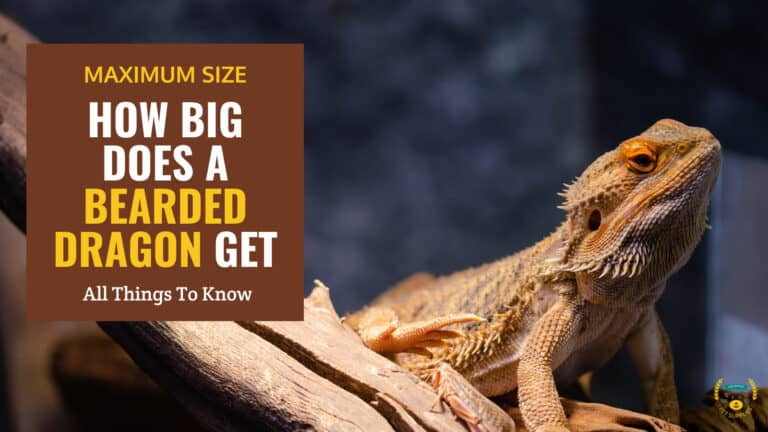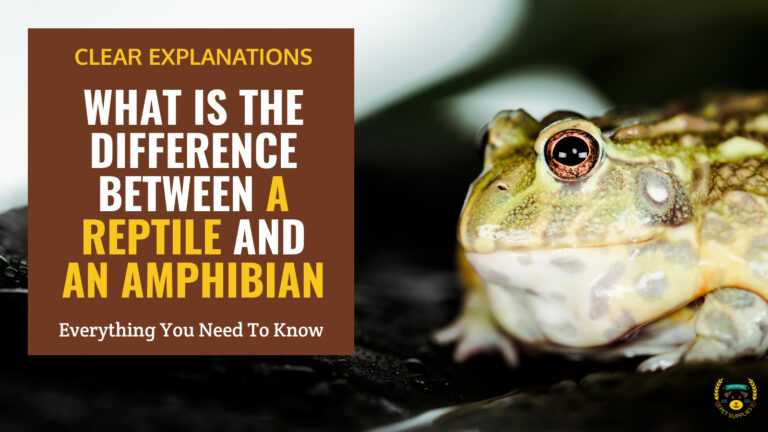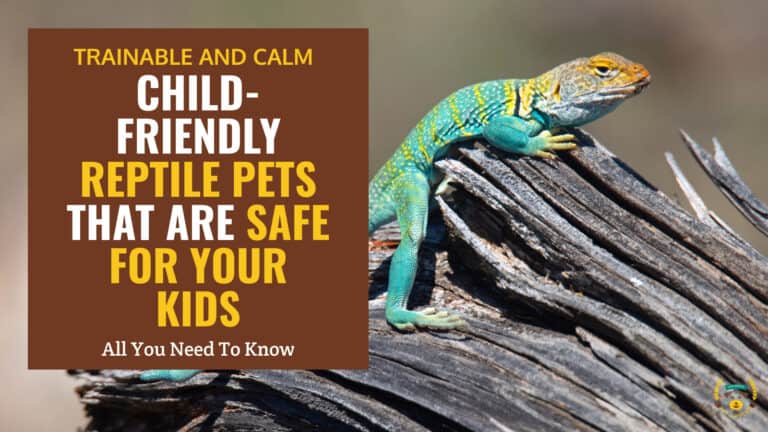How to Tell the Gender of A Bearded Dragon?
Last updated: February 3, 2024

Summary
- Males: larger, femoral pores, hemipene bulges, broader heads.
- Females: smaller, no pores or bulges, narrower heads.
- Males: arm wave, bob head, darken beard.
- Females: nest, aggressive before laying eggs.
Accurately identifying the gender of a bearded dragon is key for owners and breeders to appropriately plan for breeding, prevent unwanted behaviors, and cater habitat to their needs.
As with other reptiles, bearded dragons show distinct physical and behavioral differences between the sexes - something referred to as "sexual dimorphism". Males have some distinct physical traits that distinguish them from females. However, while helpful visual cues, physical characteristics don't always clearly differentiate gender from a subtle or juvenile lizard. Observing other behaviors provides additional validation.
In this article, we will explore the ins and outs of beardies' sexing methods to help you better identify males and females. We will also answer some frequently asked questions to ensure all the aspects of the topic are covered.
- 1) Identifying Gender by Physical Characteristics
- 2) Behaviors and Temperament Differences by Gender
- 3) Accurately Confirming Sex with Probing or Hemipenal Eversion
- 4) Preparing Proper Habitat Based on Bearded Dragon Gender
-
5)
Frequently Asked Questions
- 5.1) How Soon Can You Identify Gender in Baby Bearded Dragons?
- 5.2) Do Female Bearded Dragons Live Longer Than Males?
- 5.3) Can Two Male or Two Female Bearded Dragons Live Together?
- 5.4) Do Male Bearded Dragons Make Better Pets Than Females?
- 5.5) How Often Do Female Bearded Dragons Lay Eggs?
- 5.6) Are Intersex Conditions Common in Bearded Dragons?
- 5.7) Does Gender Impact Price for Bearded Dragon Breeders?
- 6) Final Thoughts
Identifying Gender by Physical Characteristics
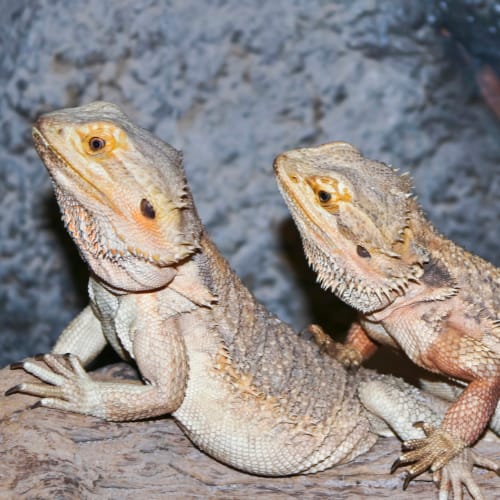
While behaviors and temperament provide good clues, visually inspecting physical traits remains the most straightforward way of identifying a bearded dragon's gender. By comparing standard male and female characteristics and watching for trait development as the bearded dragon matures, you can accurately determine the sex.
Comparing Male and Female Body Size and weight
Mature male bearded dragons generally grow larger and heavier than females. Adult males may reach 24 inches long and weigh around 600 grams by age 2.
Females top out around 18-20 inches in length and 400 grams. However, substantial size overlaps exist, especially among juvenile lizards under a year old. For more details on what's the typical adult size for a bearded dragon and other size-related information, check out our article on how big a bearded dragon gets.
Inspecting Femoral Pores on Inner Thighs
Pores on the inner thighs called femoral pores offer key differentiation. These pores appear as raised bumps or slits lined up vertically on the dragon’s hind legs. They connect to waxy secretions related to breeding pheromones.
Males sport prominent rows of femoral pores. Females lack these pores completely. Pore presence or absence gives a clear indicator of sex.
Looking for Hemipene Bulges near the Tail
Gently lift or observe the area around a male bearded dragon’s vent or cloaca opening near the tail. Two hemipene bulges should be visible on either side containing the male copulatory sex organs. Females lack these swollen bumps.
Checking for hemipenes gives further validation of the male gender.
Checking for Larger Jowls and Broader Heads in Males
Finally, the dimensions of a bearded dragon’s head region differ by gender once grown. Males develop very broad, triangular-shaped heads and sizeable jowls averaging 2.5 times the width of their necks. Females maintain a much smaller, narrower, oval-shaped head attached evenly to their slimmer necks and bodies.
Behaviors and Temperament Differences by Gender
While physical characteristics provide the most definitive gender identification, behavior and temperament observations also differ distinctly between male and female bearded dragons. Being aware of these gender-specific traits allows you to better understand your lizard.

Males Tend to Arm Wave and Head Bob to Show Dominance
Mature male dragons engage in rituals like arm waving and head bobbing to signal their dominance, especially in breeding situations. They darken their normally light beards to intensify displays towards females and competing males.
These exaggerated movements demonstrate breeding readiness. Females do not wave their arms up and down or bob heads as vigorously.
Females Nest and Become Aggressive When Ready to Lay Eggs
Meanwhile, gravid females demonstrate nesting activities like digging, biting bedding, and rearranging habitat when preparing to lay eggs. This nesting instinct drives them to ensure the best site to bury eggs.
Additionally, egg-bound females often become more aggressive, territorial, and withdrawn compared to usual docile temperaments. They guard the premium nest location from perceived competition.
One Gender Not Always Definitive, Sometimes Intersex
Finally, normal gonadal development occasionally does not occur in bearded dragons. Certain genetic conditions lead to individuals showing both male and female traits, known as intersex conditions. So while behaviors largely correlate by gender, exceptions exist where identifying precise gender remains complex even into mature ages.
Vet DNA or blood testing can assist if behavioral and physical signs conflict.
Accurately Confirming Sex with Probing or Hemipenal Eversion
For absolute certainty in determining the gender of an especially young or sexually ambiguous bearded dragon, two veterinarian-assisted methods provide definitive results.

Veterinarian Can Probe a Juvenile Bearded Dragon
Probing involves a vet carefully inserting a thin lubricated probe into the cloaca to feel for the presence or absence of a hemipenal bulge. It accurately determines the sex of young dragons under 6 months old that lack externally visible gender differences.
However, probing risks injury and stress if not performed properly under anesthesia by an experienced herp vet.
Mature Males Can Hemipenal Evert for Observation
Additionally, a vet can massage the hemipene bulges near the tail to trigger muscular evertion and extrusion of the double male copulatory organs housed internally when inactive.
Fully everting both right and left hemipenes provides undisputable confirmation of mature male status without anesthesia. However, only a qualified vet should attempt this delicate procedure.
Transitioning Gender Possible but Challenging in Bearded Dragons
In extremely rare cases, hermaphroditic or transitional bearded dragons may physically switch genders later in life, thanks to developmental irregularities. After the suspected brumation period triggers, ovaries suddenly produce testes and vice versa. However, such spontaneous sex changes remain complicated, with unlikely breeding success afterward.
So while vet physical manipulation skips guesswork for gender, the cost, risks, and mixed evidence on natural sex transitions warrant caution. Still, when all other signs conflict on whether a dragon is male or female, cloacal probing and hemipenal eversion offer guaranteed accuracy.
Preparing Proper Habitat Based on Bearded Dragon Gender
Once the gender is confidently determined, you can cater your bearded dragon's habitat and care to better meet single-sex needs. Creating an optimized home helps ensure healthy longevity, with considerations to enclosure sizes and décor, temperature ranges and nutrition, among other things.
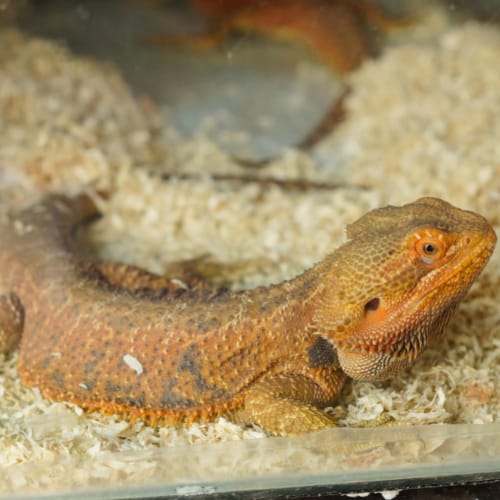
Male Enclosure Considerations for Wellbeing
Adult male dragons reach larger sizes, requiring more space to stretch and exercise. Provide an enclosure at least 40-50 gallons large with proper heat and full spectrum lighting. Include abundant ground space for walking not climbing.
Additionally, try to add visual barrier breaks if housing multiple males together. Also, monitor signs of dominance disputes like biting or food aggression.
Optimizing Female Bearded Dragon Habitat for Brumation and Egg Laying
Meanwhile, prepare habitats for healthy egg-laying cycles in females. Offer nesting boxes filled with soft bedding for burrowing and laying if breeding.
Moreover, ensure calcium-rich diets and full spectrum lighting for vitamin D to allow bone recovery post-laying. Also, cool down the enclosure for at least 2 months over winter to support the brumating reproductive system recovery. Limit clutch frequency to preserve the female's breeding health.
Frequently Asked Questions
If you still have questions related to the topic at hand, you will most probably find your answer(s) in this section, as we provide answers to the most frequently asked questions about Bearded Dragon gender and sexing methods.
How Soon Can You Identify Gender in Baby Bearded Dragons?
Gender remains challenging to identify visually in babies under 3 months old. Best practice suggests waiting until at least 5-6 months for femoral pores, hemipenal bulges, head width, and other sex characteristics to fully develop. Vet probing accurately assigns gender earlier when needed for breeding preparation.
Do Female Bearded Dragons Live Longer Than Males?
On average, female bearded dragons live slightly longer lifespans of 7-10 years compared to 5-8 years for males. The brumation reproductive rest period seems to benefit longevity. However, individual dragons prove exceptions defying gendered longevity generalizations either way.
However, several factors can influence individual lifespans. For a deeper dive into the fascinating world of bearded dragon longevity, including the impact of genetics, environment, and proper care, check out our comprehensive guide on how long a bearded dragon lives.
Can Two Male or Two Female Bearded Dragons Live Together?
Cohabitating any dragons poses risks, but same-sex pairings or trios work best. Never house mature males with receptive females except temporarily for supervised breeding.
Monitor all dragons in shared spaces for mounting, dominance, feeding issues, etc.
Do Male Bearded Dragons Make Better Pets Than Females?
While subjective, some owners believe males bond more readily with calm dispositions, enjoying human interaction. Still, gender matters far less than the individual dragon’s personality in determining quality pets.
How Often Do Female Bearded Dragons Lay Eggs?
Reproductively healthy females breed 1-2 times annually following winter dormancy. Breeding too often over-taxes nutrient stores. Try to time egg-laying periods with the seasons. Ensure 12-18 month gaps between clutches.
If infertile, some females may lay eggs without a mate.
Are Intersex Conditions Common in Bearded Dragons?
Uncommon intersex occurrences happen in an estimated 1 of 3,000 dragons. Gonadal development during egg incubation affects hormones and expression, but externally identifying such complex conditions remains exceptionally rare and challenging.
Does Gender Impact Price for Bearded Dragon Breeders?
Yes, baby male bearded dragons often cost less than females. Because mature breeding females are in shorter supply for replenishing future stock, this slightly inflates typical female pricing at about $25 more on average.
Final Thoughts
Accurately identifying bearded dragon gender remains essential for owners to appropriately plan breeding management, interpret behaviors, anticipate needs, and promote health through specialized care based on sex.
Standard physical characteristics and behavioral observations provide reliable gender identification in most dragons beyond 6 months old. Tailor enclosure considerations and owner diligence to support the best husbandry for males versus females once definitively sexed. You should also embrace occasional exceptions to gender norms, seeking vet assistance to investigate ambiguities.
Ultimately, understanding a bearded dragon's manifested gender allows better readership of their unique personality and cross-referencing of norms against their needs as individuals thriving in captivity over a decade.
Thanks for reading!



